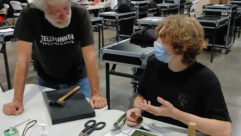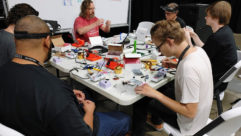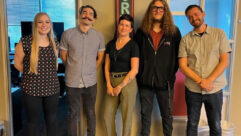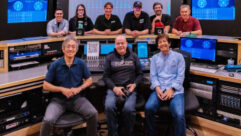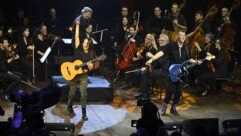Gilbert, Ariz., Sept. 24, 2019 – Being trained on industry standard products that are utilized in real-world applications is ideal for audio engineering students…but actually building your own gear with the help of industry professionals is an experience most will never be able to say that they have participated in.
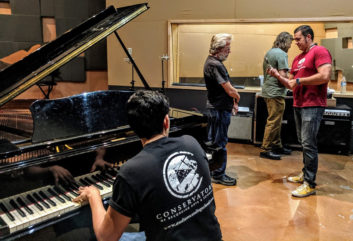
The Conservatory of Recording Arts & Sciences (CRAS; www.cras.edu), the leading institution for audio engineering education, was recently visited by Rick Wilkinson and Bob Kostlan of Austin Ribbon Microphones to conduct a DIY ribbon mic build. Dave Royer of Royer Labs also attended in order to test prototype mics with the school’s student section of the Audio Engineering Society.
“Rick and Bob made the trip and brought Dave as a special guest to test prototype DIY tube condenser microphones that Dave and Rick are designing specifically for college lab workshops,” explained David Kohr, CRAS instructor and CRAS Faculty Liaison AES Student Chapter. “The mic build happened in our Live Sound Venue, while in our Studio A Live Room Dave made realtime recordings with a stereo pair of prototype DIY Tube Condenser Microphones, which they’re co-designing as an affordable workshop for students and audio professionals alike. These were great opportunities for our students that help make getting an education from CRAS that much better.”
According to Wilkinson, this is Austin Microphones sixth year participating in a DIY Ribbon Microphone Build at CRAS. “Even though CRAS is all about the ‘behind-the-scenes’ career of audio production, it’s a great experience for us to introduce the process of actually building the tools that CRAS graduates will use in the field, especially when we can include world-class engineers such as Dave Royer to join us,” he said. “Hands-on skills with electronics…especially being comfortable opening, troubleshooting, and repairing audio equipment always pays-off in a career in audio production.”
Royer added that the recording sessions went very well. “As for the ribbon microphone building workshop, everybody in the workshop left with a working microphone, which says volumes for how well thought through Rick’s workshops are.”
Over the years, more than 70 students have built the Austin Ribbon Microphone at CRAS. “We keep in touch with students who have built the microphones, and some of them have gone on to use the mic that they’ve built in studio environments around the world, telling us that they wish they could be here again to build another one,” Wilkinson concluded. “The Austin Ribbon Mic build at CRAS is a one-of-a-kind, real-life experience that students will remember and refer to always.”
Added Kirt Hamm, CRAS administrator, “Our students are always thrilled when they have such opportunities available to them because it is an everlasting learning experience. We can’t thank Rick, Bob, and Dave enough for sharing their products and wisdom with us.”
The Conservatory of Recording Arts & Sciences is composed of two nearby campuses in Gilbert and Tempe, Ariz. A CRAS education includes Broadcast Audio, Live Sound, Audio Post for Film and TV, Music Production, Commercial Production and Video Game Audio, all taught by award-winning instructors who have excelled in their individual fields. CRAS’ structured programs, and highly qualified teaching staff, provide a professional and supportive atmosphere, which is complemented by its small class sizes allowing for individual instruction and assistance for students in engineering audio recordings. CRAS has been providing quality vocational training in Audio Recording for more than three decades. The curriculum and equipment are constantly being updated to keep pace with the rapid advancements in the music and sound recording industries. CRAS’ course offerings and subject matter have always centered around the skills and knowledge necessary for students’ success in the Audio Recording industries.
The 11-month program is designed to allow every student access to learn and train in all of the Conservatory’s studios which are comprised with state-of-the-art audio recording and mixing gear, the same equipment used in today’s finest studios and remote broadcast facilities, including Pro Tools 12, API Legacy consoles, SSL G+ and AWS consoles, Studer Vista consoles, and much more. All students must complete a 280-hour industry internship to graduate from the Master Recording Program II that may ultimately lead to industry employment.
For more information on CRAS, please visit www.cras.edu, contact Kirt Hamm, administrator, at 1-800-562-6383, or email to [email protected].
About The Conservatory of Recording Arts & Sciences
Based in the heart of The Valley of the Sun with two campuses in Gilbert and Tempe, Ariz., The Conservatory of Recording Arts & Sciences (CRAS) is one of the country’s premier institutions for audio education. The Conservatory has developed a unique and highly effective way to help the future audio professional launch their careers in the recording industry and other related professional audio categories.
-30-


